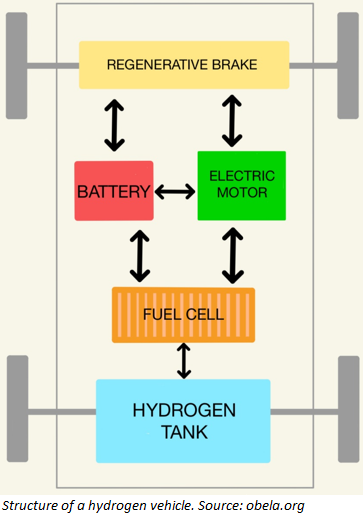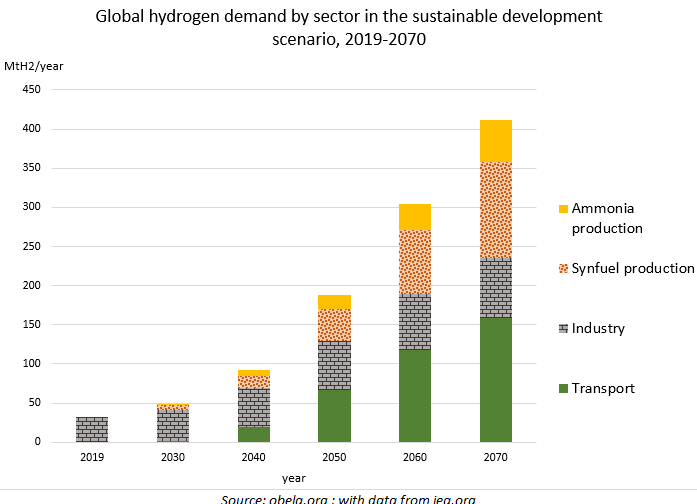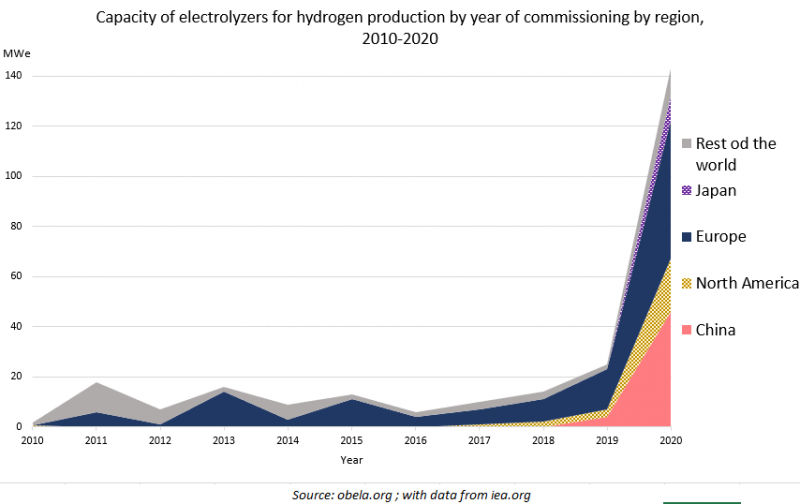In a previous note, we discussed the production of hydrogen batteries in general terms. We mention why hydrogen is considered a renewable energy source option and the route it takes in the energy matrix shift to replace gasoline at the industrial level and be harnessed in fuel cells for transport vehicles and to generate other fuels.
There are five categories of hydrogen production for energy purposes classified by colours, four by the origin, and one by treatment. There is grey hydrogen from natural gas; brown, from synthetic gas from lignite; black, from synthetic gas from coal and oil; green, from the electrolysis of water using other renewable sources; and blue, from natural gas. It resembles grey, but with an added process to capture the carbon dioxide generated.
Transforming unstable molecules, such as molecular hydrogen (H2) and molecular oxygen (O2), into a stable one, such as the water molecule (H2O), releases a large amount of energy. Work is currently underway to convert this chemical reaction energy into electrical energy. The International Energy Agency (IEA) estimates that obtaining green hydrogen would save up to 830 million tonnes of CO2 per year.

We can burn hydrogen to generate water vapour, heat, and mechanical work or generate water vapour and heat and electrical energy when using fuel cells. Hydrogen engines mainly consist of three parts: the tank containing hydrogen, a fuel cell, and an electric motor. (see graph)
The manufacture of ever more efficient cells generates technological competition. Electrolysis loses between 10-30% of the input energy in the energy generation process. Hence, its application is only feasible when there is low-cost primary energy. Hydrogen is attractive because we can store it. Volume-wise, one kilogram of hydrogen can generate the equivalent power of one gallon of gasoline (2.9 kg).
According to Wood Mackenzie, more than 90% of the hydrogen currently produced emits pollutants into the environment. Black hydrogen production a fossil fuel costs, namely natural gas. The cost of generating green hydrogen is in turn connected to electricity prices. In the long term, by 2040, the production costs of green hydrogen will be equal to those of black hydrogen in line with the price competitiveness of the photovoltaic industry and the prices of natural gas and hydrocarbons.

Global energy consumption is growing along with population, transport use, and technological change. Using hydrogen as an essential energy carrier will require a considerable increase in production volume and a new and complex infrastructure to supply it to users. Countries with wind, solar and hydroelectric energy infrastructure will have a competitive advantage in green hydrogen production.
In July 2020, the European Union presented its plan to achieve the substitution of non-renewable energies with green and blue hydrogen by 2050 to help "clean up" the continent. Its program will have an initial investment for this decade equivalent to US$50 billion. Analysts estimate that by 2050, the electricity industry will be worth US$1.2 trillion.

Hydrogen as an alternative fuel is a reality. The Japanese companies Honda, Toyota, and Mazda and the Korean company Hyundai have cars with hydrogen batteries. Currently, one of these vehicles has a range between 430 and 600 km. However, refueling stations are still few and far between. Only Europe, China, Japan, and South Korea have plans to build massive infrastructure. Two Western companies are developing hydrogen batteries, Germany's BMW and US-based General Motors. Volkswagen, which has focused on lithium, has discarded this possibility after several attempts. China specialises in deploying hydrogen batteries in heavy-duty vehicles and buses and aims to have half a million cars on the move by 2035 in its territory. Norway's Havyard is looking to implement this technology in ships, and Norway's Corvus Energy is developing lithium-based electric batteries for boats.
In this case, the route leads to fuel cells' production and increasingly efficient hydrogen production methods. Both are viable within a socio-environmental logic, which in the first instance will lead to being implemented in freight transport and services and, in the longer term, will be accessible to all users. Green hydrogen is the best fuel option we have for environmental recovery. In the Latin American and Caribbean regions, various sustainable energy production projects are in the development process. These intend to meet the Sustainable Development Goals, achieving a more extraordinary approach towards energy autonomy and, as a whole, resolving socio-cultural conflicts, as discussed, for example, in the Sustainable Energy Strategy 2030 Report of the SICA countries.










